英语2011年《随堂优化训练》人教新目标版九年级Unit 15 Section A
文档属性
| 名称 | 英语2011年《随堂优化训练》人教新目标版九年级Unit 15 Section A |  | |
| 格式 | rar | ||
| 文件大小 | 203.4KB | ||
| 资源类型 | 教案 | ||
| 版本资源 | 人教新目标(Go for it)版 | ||
| 科目 | 英语 | ||
| 更新时间 | 2011-11-04 08:00:53 | ||
图片预览

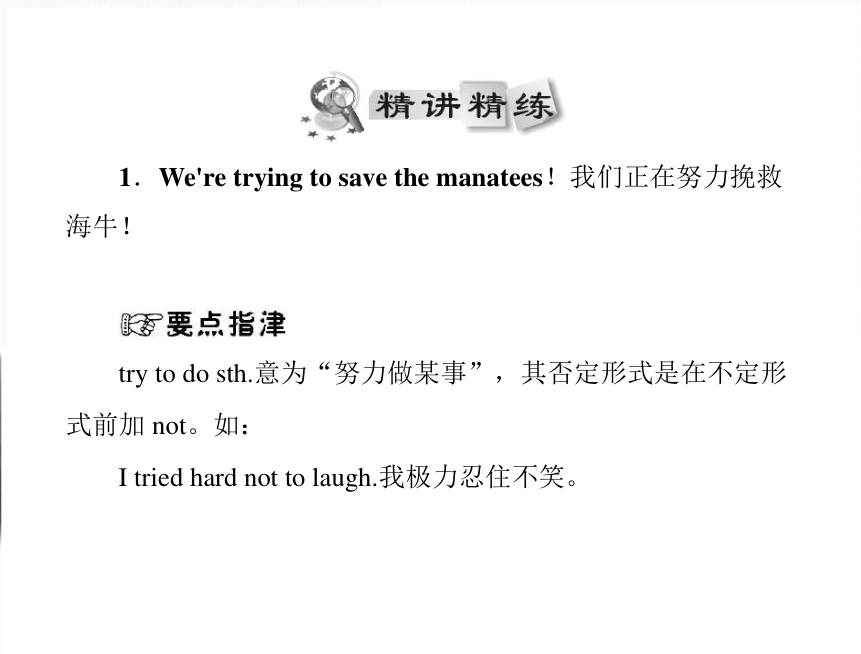
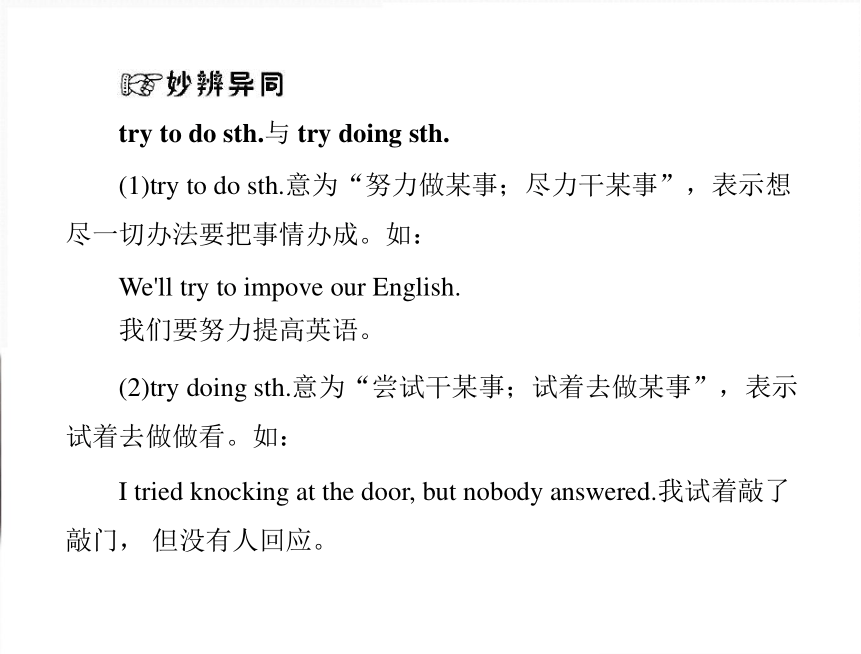
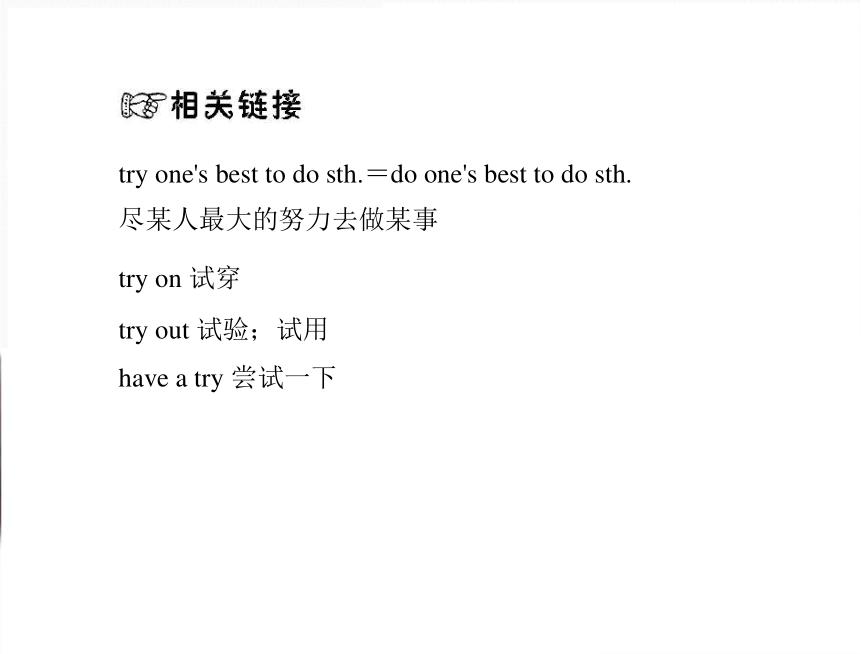
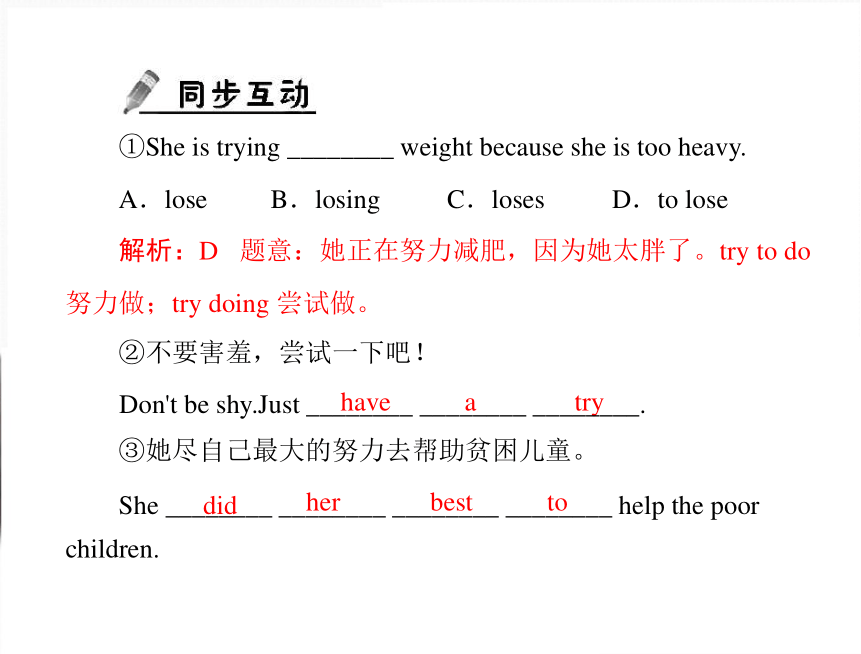
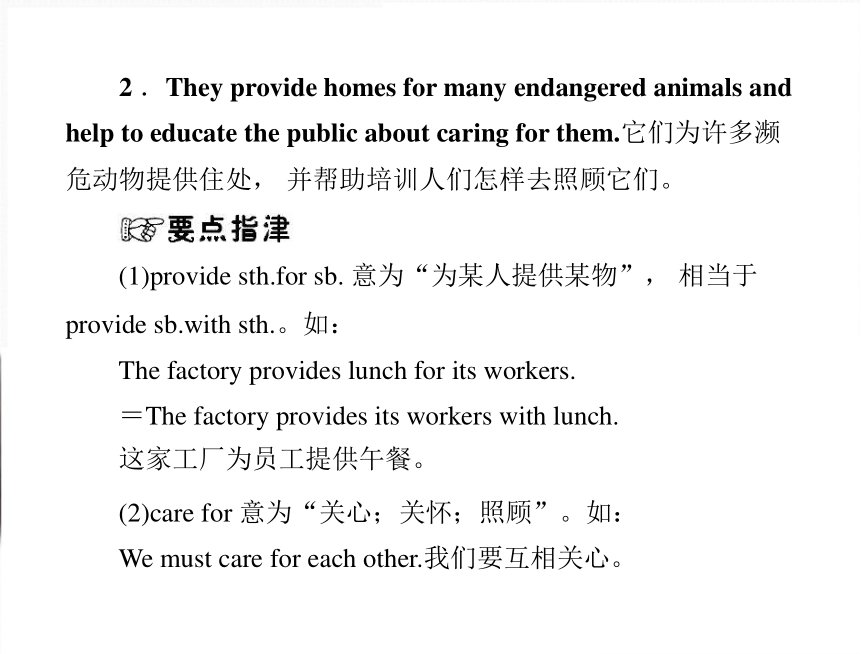

文档简介
(共17张PPT)
Unit 15
We're trying to save
the manatees!
Section A
1.We're trying to save the manatees!我们正在努力挽救
海牛!
try to do sth.意为“努力做某事”,其否定形式是在不定形
式前加 not。如:
I tried hard not to laugh.我极力忍住不笑。
try to do sth.与 try doing sth.
(1)try to do sth.意为“努力做某事;尽力干某事”,表示想
尽一切办法要把事情办成。如:
We'll try to impove our English.
我们要努力提高英语。
(2)try doing sth.意为“尝试干某事;试着去做某事”,表示
试着去做做看。如:
I tried knocking at the door, but nobody answered.我试着敲了
敲门, 但没有人回应。
try one's best to do sth.=do one's best to do sth.
尽某人最大的努力去做某事
try on 试穿
try out 试验;试用
have a try 尝试一下
①She is trying ________ weight because she is too heavy.
A.lose
B.losing
C.loses
D.to lose
解析:D
题意:她正在努力减肥,因为她太胖了。try to do
努力做;try doing 尝试做。
②不要害羞,尝试一下吧!
have
a
try
③她尽自己最大的努力去帮助贫困儿童。
She ________ ________ ________ ________ help the poor
children.
did
her
best
to
Don't be shy.Just ________ ________ ________.
2 .They provide homes for many endangered animals and
help to educate the public about caring for them.它们为许多濒
危动物提供住处, 并帮助培训人们怎样去照顾它们。
(1)provide sth.for sb. 意为“为某人提供某物”, 相当于
provide sb.with sth.。如:
The factory provides lunch for its workers.
=The factory provides its workers with lunch.
这家工厂为员工提供午餐。
(2)care for 意为“关心;关怀;照顾”。如:
We must care for each other.我们要互相关心。
(1)care for 意为“照顾”时,相当于 take care of/look after;
意为“关心”时,相当于 care about。
(2)care for 还可意为“喜欢;介意”。如:
Do you care for pop music?你喜欢流行音乐吗?
①What did the company ________ for the children in the
poor areas
A.pretend
B.offer
C.provide
D.give
解析:C
provide sth.for sb.=provide sb.with sth.为某人提
②Who is ________ the old people in the hospital
A.caring for
C.taking care
B.care about
D.look after
解析:A
care for 意为“照顾”时,相当于 take care of/look
after;句中有 be 动词 is,故应用现在进行时。
供某物。
复习动词的时态和语态
初中阶段所学的主要时态有:一般现在时、一般过去时、
一般将来时、现在进行时、过去进行时、过去将来时、现在完
成时和过去完成时。而英语中的语态分为主动语态和被动语态
两种。主动语态表示主语是谓语动作的执行者或发出者,被动
语态表示主语是谓语动作的承受者。
语态
示例
时态 主动语态 被动语态
一般现在时 do/does am/is/are done
一般过去时 did was/were done
一般将来时 am/is/are going to do am/is/are going to be
done
will/shall do will/shall be done
现在进行时 am/is/are doing am/is/are being done
下面以动词 do 为例来说明不同时态中动词的语态变化。
语态
示例
时态 主动语态 被动语态
过去进行时 was/were doing was/were being done
过去将来时 was/were going to do was/were going to be
done
would/should do would/should be done
现在完成时 has/have done has/have been done
过去完成时 had done had been done
续表
注意:(1)情态动词的被动语态的基本结构为:情态动词+
be done。
(2) 使 役 动 词 (let, make, have) 和 感 官 动 词 (see, feel, watch,
notice 等)用于被动语态时,不定式前必须加 to。如:
Betty was made to practise playing the piano every day. 贝蒂
要每天练习弹钢琴。
A stranger was being watched to enter the hall.
一个陌生人被看着走进了大厅。
①—When ________ he ________ for London
—The day before yesterday.He ________ for two days.
A.did; leave; has been away
B.has; left; has left
C.did; leave; has left
D.will; leave; is leaving
解析:A
根据答语“The day before yesterday.”可知问句用
一般过去时;根据答语第二句后面的 for two days 可知第三空用
现在完成时,且谓语动词要用延续性动词。故选 A。
②If you ________ carefully, you ________ the report well.
A.will listen; will be understood
B.will listen; understand
C.listen; will understand
D.listen; understand
if 引导的条件状语从句遵循“主将从现”原则。
解析:C
故选 C。
③—Do you know whether Mary will go there
—I'm not sure.She says she will stay at home unless she
________ to the party.
A.is inviting
C.was invited
B.invites
D.is invited
解析:D
这是一个由 unless 引导的条件状语从句。主句用
一般将来时,从句用一般现在时表将来,且 Mary 与 invite 之间
是被动关系,故选 D。
④A talk on Chinese history ________ in the school hall next
week.
A.be given
C.will be given
B.has been given
D.will give
解析:C 题意:下星期在学校礼堂将举行一个关于中国历
史的演讲。谓语 give 与主语 a talk 之间构成动宾关系,应用被
动语态;且由时间状语 next week 可知用一般将来时,故选 C。
⑤—Did you see Tom at the party
—No, he ________ by the time I got there.
A.left
B.was leaving
C.had left
D.has left
解析:C
题意:“你在晚会上看见汤姆了吗?”“没有。
他在我到之前就离开了。”by the time 意为“在……之前”,谓
语动词常用完成时。由 I got there 可知应用过去完成时。
A.talked
B.talks
C.is talking
D.was talking
解析:D
题意:当她父亲回到家时,琼正在和朋友交谈。
根据题意可知用进行时,且由 came 可知应用过去时态,故选 D。
⑥When her father came back home, Joan ________ with her
friend.
Unit 15
We're trying to save
the manatees!
Section A
1.We're trying to save the manatees!我们正在努力挽救
海牛!
try to do sth.意为“努力做某事”,其否定形式是在不定形
式前加 not。如:
I tried hard not to laugh.我极力忍住不笑。
try to do sth.与 try doing sth.
(1)try to do sth.意为“努力做某事;尽力干某事”,表示想
尽一切办法要把事情办成。如:
We'll try to impove our English.
我们要努力提高英语。
(2)try doing sth.意为“尝试干某事;试着去做某事”,表示
试着去做做看。如:
I tried knocking at the door, but nobody answered.我试着敲了
敲门, 但没有人回应。
try one's best to do sth.=do one's best to do sth.
尽某人最大的努力去做某事
try on 试穿
try out 试验;试用
have a try 尝试一下
①She is trying ________ weight because she is too heavy.
A.lose
B.losing
C.loses
D.to lose
解析:D
题意:她正在努力减肥,因为她太胖了。try to do
努力做;try doing 尝试做。
②不要害羞,尝试一下吧!
have
a
try
③她尽自己最大的努力去帮助贫困儿童。
She ________ ________ ________ ________ help the poor
children.
did
her
best
to
Don't be shy.Just ________ ________ ________.
2 .They provide homes for many endangered animals and
help to educate the public about caring for them.它们为许多濒
危动物提供住处, 并帮助培训人们怎样去照顾它们。
(1)provide sth.for sb. 意为“为某人提供某物”, 相当于
provide sb.with sth.。如:
The factory provides lunch for its workers.
=The factory provides its workers with lunch.
这家工厂为员工提供午餐。
(2)care for 意为“关心;关怀;照顾”。如:
We must care for each other.我们要互相关心。
(1)care for 意为“照顾”时,相当于 take care of/look after;
意为“关心”时,相当于 care about。
(2)care for 还可意为“喜欢;介意”。如:
Do you care for pop music?你喜欢流行音乐吗?
①What did the company ________ for the children in the
poor areas
A.pretend
B.offer
C.provide
D.give
解析:C
provide sth.for sb.=provide sb.with sth.为某人提
②Who is ________ the old people in the hospital
A.caring for
C.taking care
B.care about
D.look after
解析:A
care for 意为“照顾”时,相当于 take care of/look
after;句中有 be 动词 is,故应用现在进行时。
供某物。
复习动词的时态和语态
初中阶段所学的主要时态有:一般现在时、一般过去时、
一般将来时、现在进行时、过去进行时、过去将来时、现在完
成时和过去完成时。而英语中的语态分为主动语态和被动语态
两种。主动语态表示主语是谓语动作的执行者或发出者,被动
语态表示主语是谓语动作的承受者。
语态
示例
时态 主动语态 被动语态
一般现在时 do/does am/is/are done
一般过去时 did was/were done
一般将来时 am/is/are going to do am/is/are going to be
done
will/shall do will/shall be done
现在进行时 am/is/are doing am/is/are being done
下面以动词 do 为例来说明不同时态中动词的语态变化。
语态
示例
时态 主动语态 被动语态
过去进行时 was/were doing was/were being done
过去将来时 was/were going to do was/were going to be
done
would/should do would/should be done
现在完成时 has/have done has/have been done
过去完成时 had done had been done
续表
注意:(1)情态动词的被动语态的基本结构为:情态动词+
be done。
(2) 使 役 动 词 (let, make, have) 和 感 官 动 词 (see, feel, watch,
notice 等)用于被动语态时,不定式前必须加 to。如:
Betty was made to practise playing the piano every day. 贝蒂
要每天练习弹钢琴。
A stranger was being watched to enter the hall.
一个陌生人被看着走进了大厅。
①—When ________ he ________ for London
—The day before yesterday.He ________ for two days.
A.did; leave; has been away
B.has; left; has left
C.did; leave; has left
D.will; leave; is leaving
解析:A
根据答语“The day before yesterday.”可知问句用
一般过去时;根据答语第二句后面的 for two days 可知第三空用
现在完成时,且谓语动词要用延续性动词。故选 A。
②If you ________ carefully, you ________ the report well.
A.will listen; will be understood
B.will listen; understand
C.listen; will understand
D.listen; understand
if 引导的条件状语从句遵循“主将从现”原则。
解析:C
故选 C。
③—Do you know whether Mary will go there
—I'm not sure.She says she will stay at home unless she
________ to the party.
A.is inviting
C.was invited
B.invites
D.is invited
解析:D
这是一个由 unless 引导的条件状语从句。主句用
一般将来时,从句用一般现在时表将来,且 Mary 与 invite 之间
是被动关系,故选 D。
④A talk on Chinese history ________ in the school hall next
week.
A.be given
C.will be given
B.has been given
D.will give
解析:C 题意:下星期在学校礼堂将举行一个关于中国历
史的演讲。谓语 give 与主语 a talk 之间构成动宾关系,应用被
动语态;且由时间状语 next week 可知用一般将来时,故选 C。
⑤—Did you see Tom at the party
—No, he ________ by the time I got there.
A.left
B.was leaving
C.had left
D.has left
解析:C
题意:“你在晚会上看见汤姆了吗?”“没有。
他在我到之前就离开了。”by the time 意为“在……之前”,谓
语动词常用完成时。由 I got there 可知应用过去完成时。
A.talked
B.talks
C.is talking
D.was talking
解析:D
题意:当她父亲回到家时,琼正在和朋友交谈。
根据题意可知用进行时,且由 came 可知应用过去时态,故选 D。
⑥When her father came back home, Joan ________ with her
friend.
同课章节目录
- Unit 1 How can we become good learners.
- Section A
- Section B
- Unit 2 I think that mooncakes are delicious!
- Section A
- Section B
- Unit 3 Could you please tell me where the restroom
- Section A
- Section B
- Unit 4 I used to be afraid of the dark.
- Section A
- Section B
- Unit 5 What are the shirts made of?
- Section A
- Section B
- Review of Units 1-5
- Unit 6 When was it invented?
- Section A
- Section B
- Unit 7 Teenagers should be allowed to choose their
- Section A
- Section B
- Unit 8 It must belong to Carla.
- Section A
- Section B
- Unit 9 I like music that I can dance to.
- Section A
- Section B
- Unit 10 You're supposed to shake hands.
- Section A
- Section B
- Review of Units 6-10
- Unit 11 Sad movies make me cry.
- Section A
- Section B
- Unit 12 Life is full of the unexpected
- Section A
- Section B
- Unit 13 We're trying to save the earth!
- Section A
- Section B
- Unit 14 I remember meeting all of you in Grade 7.
- Section A
- Section B
- Review of Units 11-14
